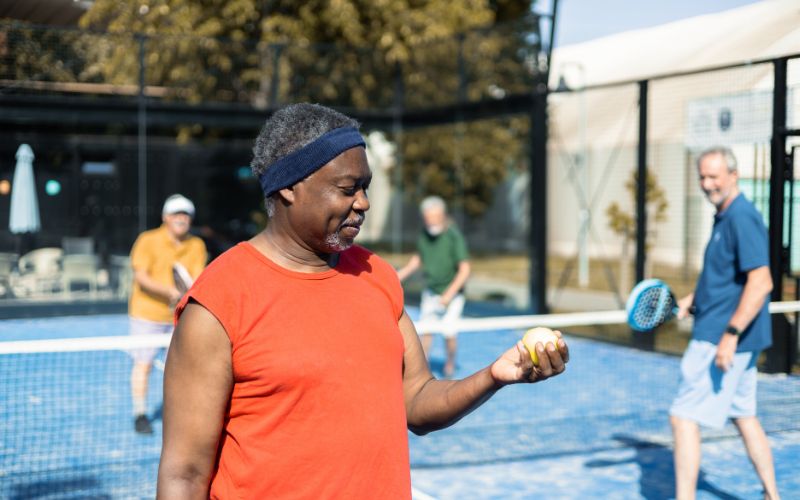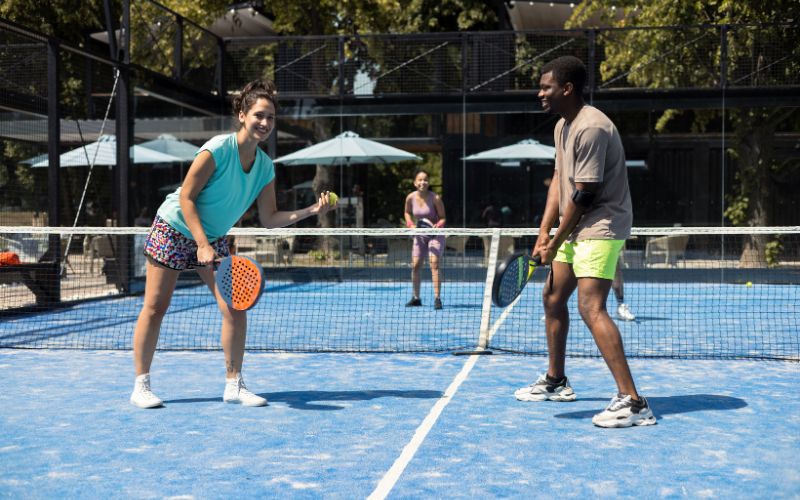In the realm of racket sports, enthusiasts are always on the lookout for something fresh and exhilarating. In recent years, two contenders have emerged as formidable alternatives to traditional tennis: pickleball and padel. These sports, while sharing some similarities, also boast unique characteristics that cater to a diverse range of players. Let’s delve into the intricacies of pickleball vs padel and explore what sets them apart.
Understanding Pickleball and Padel
Pickleball: The American Sensation
Pickleball, a sport born out of the desire for accessible recreation, combines elements of tennis, badminton, and ping pong. It is typically played on a smaller court with a perforated plastic ball and paddles resembling oversized table tennis rackets. The pickleball court features a non-volley zone close to the net, where players cannot make volleys.
Pickleball, originating from Bainbridge Island, Seattle, in 1965, emerged from the creative minds of two friends, Joel Pritchard and Bill Bell, who sought to entertain their children. Using a mishmash of sporting equipment, they improvised a game, ultimately opting for ping-pong paddles to volley a wiffle ball across a badminton court.
As families engaged in play, it became evident that they had stumbled upon something remarkable. With some rule adjustments and refinements, pickleball as we recognize it today came into existence.
The local community swiftly embraced the sport, and within a year, it became a sensation. Within a couple of years, enthusiastic neighbors began constructing their own pickleball courts, marking the beginning of its legacy.
From its modest beginnings, pickleball gradually spread across the United States, gaining notable popularity in states like California and Florida. Initially, seniors constituted the primary demographic, appreciating the sport’s appeal well ahead of younger enthusiasts.
By 1990, pickleball had permeated all 50 states. However, it wasn’t until 2009 that the inaugural national pickleball tournament took place in Buckeye, Arizona.
Subsequently, the sport experienced a substantial surge in interest, particularly during the 2020 pandemic when individuals sought outdoor recreational activities amidst ample leisure time. This surge propelled pickleball to unprecedented levels of popularity.
Padel: The European Import
Padel, on the other hand, traces its roots to Latin America before gaining popularity in Spanish-speaking countries and beyond. It shares similarities with paddle tennis and is often played on enclosed courts with glass walls and a stringless padel racket. The padel ball, similar to a depressurized tennis ball, adds to the dynamics of the game.
Padel shares a remarkably similar origin tale. Like pickleball, it emerged in the late 1960s thanks to a father seeking to engage his bored child.
Enrique Corcuera, a businessman in Mexico, encountered this scenario during a scorching summer in 1969. Despite his attempts to enjoy a siesta, his daughter persistently hit tennis balls against the house wall. Faced with the situation, Corcuera decided to construct a dedicated wall for her to play against. With a few modifications, the game of padel was born. Serendipitously, Corcuera’s esteemed friend, Prince Alfonso of Hohenlohe-Langenb, visited and enthusiastically embraced the new sport.
Upon returning to Spain, the prince introduced padel to his affluent social circle, including the King of Spain himself. Within a short span, the game gained traction, and today, over 25 million individuals partake in padel across 90 countries.
Court Dynamics and Playing Experience
Pickleball Courts
Pickleball courts are typically smaller than tennis courts and allow for fast-paced rallies due to the condensed playing area. The no volley zone near the net encourages strategic play and rewards players who can maneuver the wiffle ball effectively.
Padel Courts
Padel courts, with their glass walls and enclosed structure, offer a unique playing experience. The ball can bounce off the walls, introducing an element of unpredictability that keeps players on their toes. The smaller court dimensions foster intense exchanges and exhilarating rallies.
Scoring Systems and Gameplay
Pickleball Scoring
In pickleball, the scoring system resembles that of tennis, with games consisting of six points. However, the serving team can only score when they are serving, making for an engaging back-and-forth between the teams.
Padel Scoring
Padel, meanwhile, follows a similar scoring system to traditional tennis, with sets consisting of six games. However, the serving team has the advantage of serving underhand, which can lead to diverse strategies during play.
Accessibility and Community Engagement
Pickleball’s Rise in Community Centers
Pickleball has experienced a surge in popularity, especially in community centers and recreational facilities. It’s simple rules and inclusive nature appeal to players of all ages and skill levels, fostering a vibrant and welcoming community.
Padel’s Expansion in Europe and Beyond
Padel, while still relatively new in many regions, is quickly gaining traction as one of the fastest-growing sports globally. Its blend of speed, strategy, and social aspect makes it an attractive option for both casual players and serious competitors.
Conclusion: Embracing Diversity in Racket Sports
In the battle of pickleball vs padel, there’s no clear winner. Each sport offers its own unique blend of excitement and camaraderie, catering to a diverse array of players. Whether you’re drawn to the rapid exchanges of pickleball or the strategic nuances of padel, one thing is certain: the world of racket sports has never been more vibrant or inviting.
As pickleball and padel continue to captivate enthusiasts worldwide, their influence extends far beyond the confines of tennis courts and padel courts. They represent a testament to the enduring appeal of racquet sports and serve as a reminder that innovation and tradition can coexist harmoniously on the playing surface. So, whether you’re smashing volleys in a pickleball court or executing precise shots in a padel court, the spirit of competition and camaraderie unites players across borders and generations.
FAQs: Pickleball vs Padel
What distinguishes pickleball and padel from traditional tennis?
Pickleball and padel offer unique variations from traditional tennis. Pickleball combines elements of tennis, badminton, and ping pong, featuring smaller courts and perforated plastic balls. Padel, originating from Latin America, incorporates glass-walled courts and stringless padel rackets, creating distinct playing dynamics.
How did pickleball and padel originate?
Pickleball originated in 1965 on Bainbridge Island, Seattle, when Joel Pritchard and Bill Bell improvised a game using ping-pong paddles and a wiffle ball to entertain their children. Similarly, padel emerged in the late 1960s when Enrique Corcuera in Mexico created a game for his daughter, eventually leading to the introduction of padel to Spain by Prince Alfonso of Hohenlohe-Langenburg.
What are the key differences in court dynamics between pickleball and padel?
Pickleball courts are smaller than tennis courts and include a non-volley zone near the net, encouraging strategic play with wiffle balls. Padel courts, featuring glass walls and smaller dimensions, introduce an element of unpredictability as the ball can bounce off walls, fostering intense exchanges and rallies.
How do the scoring systems of pickleball and padel compare?
Pickleball follows a scoring system similar to tennis, with six-point games where only the serving team can score. Conversely, padel also adopts a tennis-like scoring system with sets consisting of six games, but the serving team has the advantage of serving underhand, influencing gameplay strategies.
Which demographic groups have embraced pickleball and padel?
Initially popular among seniors, pickleball gained momentum across all age groups, particularly during the 2020 pandemic, due to its accessible rules and inclusive nature. Padel, originating from Latin America and gaining popularity in Europe and beyond, attracts players of varying skill levels, contributing to its status as one of the fastest-growing sports globally.




